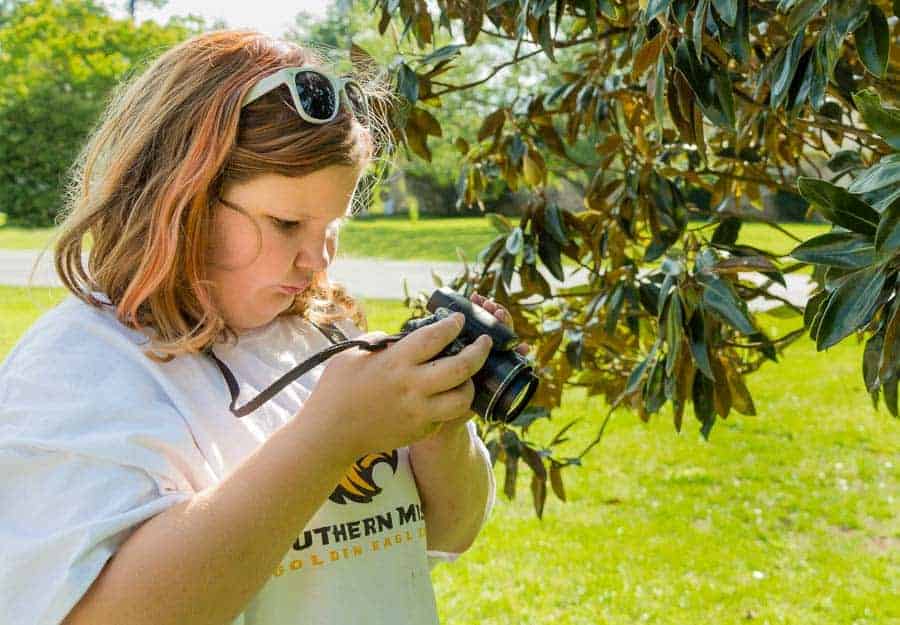

I envy today’s children. Unlike my childhood, there is no direct cost for taking a photo. Unwanted photos can easily be deleted from the memory card and that card used over and over. When I got my first camera at the ripe old age at 7 (a very sporty Bugs Bunny camera), my parents constantly reminded me to not “waste pictures” because each exposure had a very real financial cost associated with it. As a result, children of my generation were not able to explore their creativity with a camera, but today, we are seeing talented photographers develop at younger ages because they are able to develop (no pun intended) their abilities before most people my age ever had a “real” camera.
Natural attraction to photography
As an infant grows into a toddler and then into a young child, they quickly grow accustomed to seeing their parents behind a camera. In fact, for many of us, it was the arrival of a child that prompted us to become more serious about photography. Because one of a child’s first methods of learning is by imitating their parents, it should be no surprise that children want to use cameras.
And why shouldn’t a child be attracted to photography? Much of a young child’s play—whether it be drawing with crayons, building with blocks or legos, or even playing pretend—is an attempt to recreate something they have seen or experienced. What better method of recreating something than taking a photograph of it?
Children see the world in fresh ways that adults do not. In fact, most of us struggle to regain that creativity and unique viewpoints we had as children. Children are naturally artistic. They experiment. They are not afraid to take a creative risk. These are all traits that aid a photographer.

Mobile Devices
I suggest that your child’s first camera should be a mobile device—perhaps an old smartphone that has had the cellular service disconnected. Put an Otterbox or similar case on that device, and it’s practically indestructible. Similarly, there are digital cameras purposely built for children. Those cameras are so “armored” that they are practically bulletproof.
These cameras are very basic, and that's exactly what you want at this point. The camera should not be so complicated that it cannot be used by the child. All the child should be concerned with is putting the subject of the photo in the frame and pressing a button to take the pic. The goal is to simply get your child used to taking pictures. Depending on your child's age, this may only hold their interest for a few minutes at a time anyway.

Point-and-Shoot
Next, you will want to move your child up to a point-and-shoot (P&S) camera. As the cameras in mobile devices become more and more capable, you may not even want to do this. My daughter wanted a P&S, even though she had an iPhone because it was “a real camera,” and for her tenth birthday, we bought her a used Panasonic Lumix. She felt more grown-up by having a camera that was not part of another device.
One of the most important things about having a camera, as opposed to a mobile device, in my opinion, is that it provides an opportunity to teach a child to take care of a camera. Unlike smartphones, tablets, and other mobile devices, cases that will stop everything short of high caliber ammunition usually aren’t available for cameras. As such, it taking care of a camera takes a little more thought. For example, my daughter has learned how to clean a lens, the benefits and advantages of lens filters, and how to change and take care of batteries.
If you have a camera with a viewfinder, try to find your child a camera with one as well. Just about every P&S has a view screen on the back, but having one with a viewfinder gives your child options. You child is probably used to only using a view screen up to this point, but the viewfinder gives the child something that is more like mom or dad’s camera. If your child is used to seeing you use a viewfinder, they will probably be very anxious to use theirs since that is what grown-ups do with “real cameras.”
If you decide to bypass the P&S and stick to using a mobile device, look into more advanced camera apps. Not only can this add special shooting modes, but some Android camera apps can shoot in raw, enabling greater freedom if you or your child are post-processing the photos. While iOS does not allow any apps to record raw files, some apps, such as ProCamera and Camera+, allow images to be recorded in tiff format. Unlike jpegs, these files are not compressed, preserving more of the data for use during post-processing.
Whether your child uses a P&S, a mobile device’s basic camera app, or a more advanced app, you should make sure you do the next step with your child.
Teach Your Child to Use the Camera’s Features
Almost anyone two years or up can point a camera at the subject and press a button. Most cameras, even on the most basic mobile device, can do much more than that. To utilize the camera to its fullest, your child will need to learn to use its features.
You may have to read the dreaded manual to do this. But never fear. If you are one of those people who find manuals to be incomprehensible, see if the camera came with a CD or DVD. Some manufacturers have begun including instructional videos with their cameras. If there’s no video, or you just didn’t get a CD/DVD, try the manufacturer’s website. If you still haven’t had any luck, check out YouTube. Chances are good that someone has uploaded a video explaining how to use the camera.
As a last resort, you may just want to let your child explore the camera for a while, and then ask them what they have learned. You know how children are with electronics; your child can probably teach you a thing or two about the camera!
Teach the Basics
Eventually, you want to provide some guidance to that unbridled enthusiasm and teach the child some of the basics of photography. This goes hand in hand with how to use the camera’s features. For example, many cameras can display guidelines for the rule of thirds, so use that to help teach your child composition basics.
If the camera has manual controls or shutter priority or aperture priority, and even many P&S cameras have rudimentary manual controls, you can begin teaching the exposure triangle. Teach them how to freeze action by using a fast shutter speed, or how to creatively blur motion by dragging the shutter. One of my daughter’s first questions about using a camera was how to get a shallow depth of field (of course, she didn’t use that term). Photography is full of teachable moments.Post-Processing

Post-Processing
Chances are that you use Lightroom or another “advanced” photo editing application. You can help your child learn that if you wish, but that is probably too advanced for them, at least at first. Both Windows and Mac operating systems include basic photo editing and organizing applications. Additionally, there are online applications such as Google Photos, PicMonkey, and more. Even Flickr has a basic photo editor.
At the very least, you’ll want to teach your child to download the photos from the camera or memory card onto a computer. If you don’t want your child to use a computer, there are some excellent post-processing apps available on both iOS and Android, such as Snapseed. Many of the advanced camera apps also have built-in editing capabilities.
Once in the post-processing app, whether they are post-processing on a computer or on a mobile device, show your child how to use the controls. At first, it may be as simple as using the one-button “auto-fix” most apps seem to have. Depending on both your and your child’s level of talent and comfort with the app, you may want to teach her how to crop the photos, how to adjust colors and exposure, all the way up to using Photoshop.
Don't worry about your child editing the photo perfectly. Just like a young child coloring a picture with crayons, this is about creativity. You may not like the way it is edited, and that's fine. As your child gets more comfortable with editing photos, you can gently guide her into a “more mature” editing style.

Print their Photos
What parent doesn’t proudly display their child’s creations? Photographs shouldn’t be any different than the macaroni masterpiece she made in preschool.
I have read that today’s children are the most photographed generation in history, yet fewer of their photos of them are displayed. I’m not sure if whoever said that is considering sharing on Facebook and other social media as “displaying” the photos, but as far as tangible honest-to-goodness photographs, they are probably correct. Most of our photographs are relegated to some digital shoe box on our computers.
Ask your child to select some of their favorite photographs to print. This is better than you choosing the photos because you may let artistic merit creep into the decision, but for the child it will be all about the feeling of pride and accomplishment.
You don't have to spend big bucks for the prints; you can even have them printed at the local mega store or pharmacy for a few cents each. Yes, I know you can usually get better quality prints elsewhere, but this isn't about having the very best to display. The simple act of displaying your child's photos somewhere in the home will encourage your child tremendously. Print some more every month or so to keep the display fresh. This results in not only making your child proud but also making the child feel loved.
Spend Time Together
My daughter and I love to go on photo walks. We will find some place we can just walk around—whether our neighborhood, the zoo, a park, or elsewhere—to take photos. We will make up some objective, such as concentrating on shapes, shadows, colors, or sometimes it’s just a free-for-all and photographing whatever strikes our fancy.
Look into local photo groups. Depending on your child and the group, you both may be able to attend meetings and take part in the group’s activities.
The main thing is to spend time together. One of the reasons your child is interested in photography is likely because you are interested in photography. Don’t waste that opportunity; your child will be grown and out of the house before you know it.
Don’t Overdo It
If you’re a regular reader of Improve Photography, you could probably spend all day taking pictures. No matter how much your child loves photography, chances are it won’t hold their interest for that long. That’s just part of being a child, so you should not force your child to take part in any photographic activity any longer than they want to. That’s the quickest way to change photography from something they WANT to do into something they HAVE to do.
Incorporate Their Other Interests
One way to keep your child interested is to incorporate their interests. If your child loves animals, take frequent trips to the zoo to take pictures of the exotic creatures. If your child loves heavy equipment, see if there’s a construction site where you can stand safely out of the way but photograph the bulldozers and other machines as they lumber along. The point is, there is some way to add some variety to both your and your children’s photographs that will also entice their interests. You just may have to get a little creative to think of a way.
Provide Loving Critiques
Every child loves showing off to their parents. This includes their photos. Of course, you want to praise them. However, after a point, praise isn’t going to help them. Your child will need some constructive criticism in order to improve.
Of course, this needs to be tempered by the child’s age and their skill level. There is an artist inside every child, and you don’t want your criticism to snuff out that artist. You know your child, and only you can figure out how to best teach them to correct their mistakes without being overly critical.
Show them your bad photos too. Even adults get discouraged looking at other people's photos because, naturally, only the best photos are displayed. Let them see that bad shots are just part of the game. Everybody has them, so it's no need to get discouraged.

Let Your Child Take Their Camera With Them
I’m not saying that they should take the camera everywhere, but certainly you should give them the freedom to do so. This is one of the benefits of using a mobile device for a camera or using a small P&S. As the saying goes, the best camera is the one you have with you. It never fails that you see something incredible when you don’t have your camera; so does your child.
My daughter likes to take her camera with her when she rides her bike around the neighborhood. She will stop and take a picture of flowers. clouds, the neighbors' pets, or anything else that strikes her fancy. By taking her own photos when I’m not around, she’s developing her own photographic style and exploring the world in her way.
Make a Photograph Instead of Take a Picture
I’ve heard it said that photographs are made, pictures are taken. This was—and is—one of the hardest lessons for me to learn. Chances are it’s one of yours and one of your child’s as well.
When I see something that interests me, I tend to take a photo immediately from where I first saw it. If you’ve ever been to Disney World or Disneyland, you’ve seen this happen. People enter under the train station, see the castle, and they stop to take a picture right there. They don’t put any thought into the light, the composition, or many other factors that can turn a picture into a photograph.
Teach your child to not always snap the first picture they see. They should move around the subject, and change their angle relative to the subject. Find the best angle for the photograph. If they can harmlessly move a distraction out of the frame, they should do so. (This is what I usually forget to do).
A good exercise to teach (or learn) this is to find an object and take ten or so photos of it. Each photo should be different and have some thought put into it. Teach your child to ask, “Why?” before they push the shutter;
It’s Not About Art
Photography is an art. Studying art has many cognitive benefits, but that’s not the real reason for encouraging your child’s love for photography. As I’ve alluded, it is about finding something that you can do together so that years from now, both of you will not only have the photographs for memories, but also the memories behind the photographs.

Great tips. My 11 year old has shown an interest and I love going off on shooting adventures with her! It’s great having someone to share it with and fm she has such an interest in learning what I want to teach her.
Yes it is! It’s so hard at times to not overwhelm them. I would love to show my daughter how to use Lightroom and Photoshop, but I think that is over her head at this point. On the other hand, she is naturally artistic and can draw almost anything. I think if she had a good teacher for Photoshop (better than me) she could really do some great stuff!
Photography is the science, workmanship, application, and routine with regards to making solid pictures by recording light or other electromagnetic radiation, either electronically by methods for a picture sensor, or synthetically. Culminate Love Photography is a South Florida based picture boutique work in youngsters and family photography.